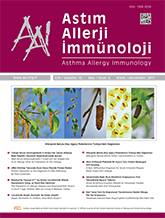


Objective: One of the many factors that involved with the pathogenesis of atopic dermatitis (AD) is sensitivity to allergens. Food allergy is a known etiological factor and evidence connecting sensitivity to inhalant allergens with atopic dermatitis also keeps increasing. Our study aimed to investigate allergen hypersensitivity together with clinical features and allergic parameters of children with atopic dermatitis who live in İstanbul.
Materials and Methods: A total of 826 children aged 2-18 years who had been followed-up with an AD diagnosis at the İstanbul University Medical School`s Allergy and Immunology Department between January 2010 and December 2013 were included in our study. Age, gender, atopy history in the family, serum levels of total IgE, presence of additional allergic disease, eosinophil percentage in total blood count and the results of skin prick tests were recorded for these patients.
Results: Among the patients included in the study, 41.2% (n:340) were female and 58.8% (n=486) were male, and the mean age was 6.48±3.50 years. Atopic children made up 80% and non-atopic children 20% of the patient population. Patients whose Ig E level was >100 were found to be more sensitive to allergens (p<0.001). As age increased, sensitivity to allergens also increased (p<0.001). Accompanying respiratory allergic diseases were not found to be related with sensitivity to allergens (p=0.07). The most frequent allergens in this study were house dust mite, sweet vernal grass, and cynodon dactylon.
Conclusion: We found that 80% of the children with atopic dermatitis who lived in İstanbul were atopic and the most frequent allergen we came across was house dust mite. When dealing with AD patients who are resistant to therapy, house dust mite allergy should be considered and relevant precautions may be clinically useful.